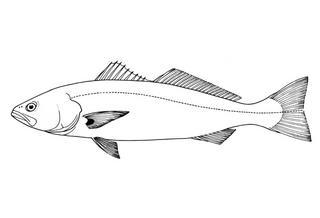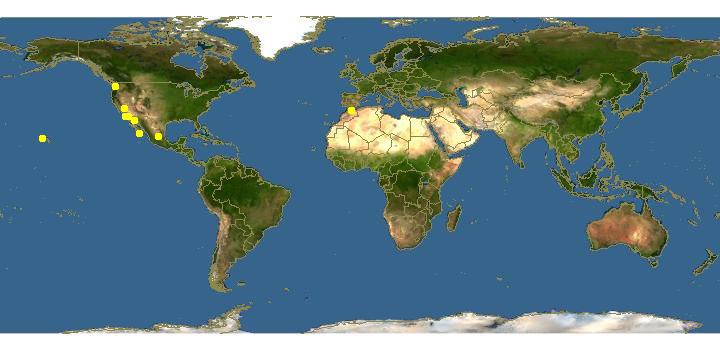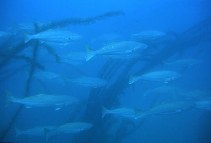
www.fao.org Copyright Michel Lamboeuf · 0
Atractoscion nobilis |

Click on map for details about points.
|
| Links |
We parsed the following live from the Web into this page. Such content is managed by its original site and not cached on Discover Life. Please send feedback and corrections directly to the source. See original regarding copyrights and terms of use.
- FishBase
|
|
español |
|
|
Overview | |
Main identification features
Elongate, fusiform, compressed, oval cross-section; eye moderate; mouth at front, weakly oblique, ends at rear of eye, lower jaw slightly projecting; no barbels on chin; teeth in multiple rows, front teeth pointed but are not canines; preopercle smooth; 13-18 rakers on 1st gill arch; raised ridge down center of belly; dorsal with long base, deep notch, X-XI, 19-23; anal II, 9-10, spines thin and short, 2nd spine ~1/2 length of 1st ray; pectoral and pelvics short; tail straight to slightly concave; scales small, all rough except smooth around eye, 70-85 on lateral line, fins not scaly.
Metallic blue to coppery above, with dark specks; belly silver; inner base of pectoral with black blotch; juveniles 3-6 dark bars on upper back, dusky yellow fins.
Size: 166 cm; 38 kg..
Habitat: rocky and algal bottoms.
Depth: 1-125 m.
Alaska to the Gulf of California.
Attributes
Abundance: Common.
Cites: Not listed.
Climate Zone: North Temperate (Californian Province &/or Northern Gulf of California); Northern Subtropical (Cortez Province + Sinaloan Gap); Northern Tropical (Mexican Province to Nicaragua + Revillagigedos).
Depth Range Max: 125 m.
Depth Range Min: 1 m.
Diet: octopus/squid/cuttlefish; bony fishes.
Eastern Pacific Range: Northern limit=50; Southern limit=22; Western limit=-124; Eastern limit=-106; Latitudinal range=28; Longitudinal range=18.
Egg Type: Pelagic; Pelagic larva.
Feeding Group: Carnivore.
FishBase Habitat: Demersal.
Global Endemism: TEP non-endemic; East Pacific endemic; All species.
Habitat: Estuary; Reef associated (reef + edges-water column & soft bottom); Sand & gravel; Rocks; Soft bottom (mud, sand,gravel, beach, estuary & mangrove); Reef (rock &/or coral); Reef and soft bottom.
Inshore Offshore: Inshore; Inshore Only.
IUCN Red List: Not evaluated / Listed.
Length Max: 166 cm.
Regional Endemism: Continent; Temperate Eastern Pacific, primarily; Tropical Eastern Pacific (TEP) non-endemic; California province, primarily; Continent only; All species.
Residency: Resident.
Salinity: Marine; Brackish.
Water Column Position: Bottom; Bottom only;
|
|
|
Names | |
|
|
|
Links to other sites | |
|
|
|
References |
- Ayres, W. O., 1860., Description of fishes., Proceedings of the California Academy of Sciences (Series 1), 2:77-81.
- Breder, C.M. Jr., 1936., Scientific results of the second oceanographic expedition of the "Pawnee" 1926. Heterosomata to Pediculati from Panama to Lower California., Bull. Bingham Oceanogr. Collect. Yale Univ., 2(3):1-56.
- Castri-Aguirre, J.L., Espinoza-Pérez, H. and Schmitter-Soto, J.J., 2002., Lista sitemática, biogeográfica y ecológica de la ictiofauna estuarino lagunar y vicaria de México. En: Lozano-Vilano, M. L. (Ed.). Libro Jubilar en Honor al Dr. Salvador Contreras Balderas., Universidad Autonoma de Nuevo León:117-142.
- Castro-Aguirre, J.L., 1999., Ictiofauna estuarino-lagunar y vicaria de México., Editorial Limusa S.A. de C.V.: 1-629pp.
- Eschmeyer , W. N. , Herald , E. S. and Hamman, H., 1983., A field guide to Pacific coast fishes of North America from the Gulf of Alaska to Baja California. Peterson Field Guide Ser. 28., Houghton Mifflin:336pp.
- Findley, L.T., Hendrickx, M.E., Brusca, R.C., van der Heiden, A.M., Hastings, P.A., Torre, J., 2003., Diversidad de la Macrofauna Marina del Golfo de California, Mexico., CD-ROM versión 1.0. Projecto de la Macrofauna del Golfo . Derechos reservados de los autores y Conservación Internacional.
- Fischer , W. , Krup , F. , Schneider , W. , Sommer , C. , Carpenter , K. E. and Niem, V. H., 1995., Guia FAO para la Identificacion de Especies de para los fines de la Pesca. Pacifico Centro-Oriental. Volumen III. Vertebrados - Parte 2., FAO3:1201-1813.
- Galván-Magaña, F., Gutiérrez-Sánchez, F., Abitia-Cárdenas, L.A., Rodríguez-Romero, J., 2000., The distribution and affinities of the shore fishes of the Baja California Sur lagoons. In Aquatic Ecosystems of Mexico: Status and Scope. Eds. M. Manuwar, S.G. Lawrence, I.F. Manuwar & D.F. Malley. Ecovision World Monograph Series., Backhuys Publishers:383-398.
- Love, M.S., Mecklenburg, C.W., Mecklenburg, T.A., Thorsteinson, L.K., 2005., es of the West Coast and Alaska: a checklist of North Pacific and Artic Ocena species from Baja California to the Alaska-Yukon border., U.S. Department of the Interior, U.S. Geological Survey, Biological Resources Division, 288pp.
- Minckley, W.L., 2002., Fishes of the lowermost colorado river, its delta, and estuary: a commentary on biotic change. En: Lozano-Vilano, M. L. (Ed.). Libro Jubilar en Honor al Dr. Salvador Contreras Balderas., Universidad Autonoma de Nuevo León:63-78.
- Pondella II, D.J., Gintert, B.E., Cobb, J.R., Allen, L.G., 2005., Biogeography of the nearshore rocky-reef fishes at the southern and Baja California islands., Journal of Biogeography, 32:187-201.
|
|
|
Acknowledgements | |
I thank Ashley MacDonald and John Pickering, University of Georgia, for technical support in building this page.
|
|
| Supported by | |
|
Following modified from FishBase
|
Top | See original
http://www.fishbase.org/Summary/speciesSummary.php?genusname=Atractoscion&speciesname=nobilis ---> http://192.134.151.83/Summary/speciesSummary.php?genusname=Atractoscion&speciesname=nobilis
http://192.134.151.83/Summary/speciesSummary.php?genusname=Atractoscion&speciesname=nobilis ---> https://fishbase.mnhn.fr/Summary/speciesSummary.php?genusname=Atractoscion&speciesname=nobilis
https://fishbase.mnhn.fr/Summary/speciesSummary.php?genusname=Atractoscion&speciesname=nobilis ---> https://fishbase.mnhn.fr/summary/Atractoscion-nobilis.html
Atractoscion nobilis, White weakfish : fisheries, gamefish

You can
sponsor
this page
Common name (e.g. trout)
Genus + Species (e.g. Gadus morhua)
-

-
About this page
-
Languages
-
User feedbacks
-
Citation
-
Uploads
-
Related species
-


 White weakfish
Add your observation in
Fish Watcher
Upload your
photos
and
videos
White weakfish
Add your observation in
Fish Watcher
Upload your
photos
and
videos
Pictures
|
Google image
 Atractoscion nobilis
Atractoscion nobilis
Picture by
Steele, M.A.
Teleostei (teleosts) >
Eupercaria/misc
(Various families in series Eupercaria) >
Sciaenidae
(Drums or croakers)
Etymology:
Atractoscion:
Greek, atraktos, arrow + Greek, skion, skiaina = barbel, red mullet (Ref.
45335
)
.
More on author:
Ayres
.
Environment: milieu / climate zone / depth range / distribution range
Ecology
Marine; demersal; depth range 0 - 122 m (Ref.
2850
). Subtropical; 65°N - 22°N
Eastern Pacific: Alaska to southern Baja California, Mexico and the Gulf of California.
Size / Weight / Age
Maturity: L
m
?
range ? - ? cm
Max length : 166 cm TL male/unsexed; (Ref.
40637
); common length : 100.0 cm TL male/unsexed; (Ref.
9118
); max. published weight: 41.0 kg (Ref.
2850
); max. reported age: 20 years (Ref.
56049
)
Dorsal
spines
(total): 10 - 11;
Dorsal
soft rays
(total): 20-23;
Anal
spines
: 2;
Anal
soft rays
: 8 - 9;
Vertebrae
: 24. Pelvic fins with fleshy appendage at base.
Often in schools over rocky bottom and in kelp beds (Ref.
2850
). Also found in the surf zone (Ref.
2850
). Young in bays and along sandy beaches (Ref.
2850
). Feed on fishes, squids, and crayfish (Ref.
6885
). Pelagic spawners (Ref.
56049
). Excellent food fish (Ref.
9118
).
Pelagic spawner (Ref.
56049
).
Eschmeyer, W.N., E.S. Herald and H. Hammann
, 1983. A field guide to Pacific coast fishes of North America. Boston (MA, USA): Houghton Mifflin Company. xii+336 p. (Ref.
2850
)
IUCN Red List Status (Ref.
130435
)
Least Concern (LC)
; Date assessed:
03 September 2019
CITES
Not Evaluated
Not Evaluated
Threat to humans
Harmless
Human uses
Fisheries: minor commercial; gamefish: yes
FAO - Fisheries:
landings
; Publication:
search
|
FishSource
|
Sea Around Us
More information
Countries
FAO areas
Ecosystems
Occurrences
Introductions
Stocks
Ecology
Diet
Food items
Food consumption
Ration
Common names
Synonyms
Metabolism
Predators
Ecotoxicology
Reproduction
Maturity
Spawning
Spawning aggregation
Fecundity
Eggs
Egg development
Age/Size
Growth
Length-weight
Length-length
Length-frequencies
Morphometrics
Morphology
Larvae
Larval dynamics
Recruitment
Abundance
BRUVS
References
Aquaculture
Aquaculture profile
Strains
Genetics
Electrophoreses
Heritability
Diseases
Processing
Nutrients
Mass conversion
Collaborators
Pictures
Stamps, Coins Misc.
Sounds
Ciguatera
Speed
Swim. type
Gill area
Otoliths
Brains
Vision
Tools
Bio-Quiz
|
E-book
|
Field guide
|
Length-frequency wizard
|
Life-history tool
|
Point map
|
Classification Tree
|
Catch-MSY
|
Special reports
Check for Aquarium maintenance
|
Check for Species Fact Sheets
|
Check for Aquaculture Fact Sheets
Download XML
Summary page
|
Point data
|
Common names
|
Photos
Internet sources
AFORO (otoliths) |
Aquatic Commons
|
BHL
|
Cloffa
|
BOLDSystems
|
Websites from users
|
Check FishWatcher
|
CISTI
|
Catalog of Fishes
:
genus
,
species
|
DiscoverLife
|
ECOTOX
| FAO - Fisheries:
landings
; Publication:
search
|
Faunafri
| Fishipedia |
Fishtrace
| GenBank:
genome
,
nucleotide
|
GloBI
|
Google Books
|
Google Scholar
|
Google
|
IGFA World Record
|
MitoFish
|
Otolith Atlas of Taiwan Fishes
|
PubMed
| Reef Life Survey | Socotra Atlas |
Tree of Life
| Wikipedia:
Go
,
Search
| World Records Freshwater Fishing |
Zoological Record
Estimates based on models
Preferred temperature (Ref.
123201
): 9 - 22.9, mean 12.8 °C (based on 76 cells).
Phylogenetic diversity index (Ref.
82804
): PD
50
= 0.5312 [Uniqueness, from 0.5 = low to 2.0 = high].
Bayesian length-weight: a=0.00794 (0.00404 - 0.01563), b=3.07 (2.91 - 3.23), in cm total length, based on LWR estimates for this species & (Sub)family-body (Ref.
93245
).
Trophic level (Ref.
69278
): 4.3 ±0.70 se; based on food items.
Generation time: 8.6 ( na - na) years. Estimated as median ln(3)/K based on 1
growth studies.
Resilience (Ref.
120179
): Low, minimum population doubling time 4.5 - 14 years (K=0.13; tm=4; tmax=20).
Fishing Vulnerability (Ref.
59153
): High to very high vulnerability (70 of 100).
Climate Vulnerability (Ref.
125649
): Moderate to high vulnerability (48 of 100).
Price category (Ref.
80766
):
Very high
.
Nutrients (Ref.
124155
): Calcium = 34.4 [18.9, 68.5] mg/100g; Iron = 0.84 [0.43, 1.49] mg/100g; Protein = 19.8 [18.7, 20.9] %; Omega3 = 0.289 [0.167, 0.463] g/100g; Selenium = 38 [18, 79] μg/100g; VitaminA = 11.2 [3.3, 39.3] μg/100g; Zinc = 0.43 [0.31, 0.64] mg/100g (wet weight);
Back to Search
Random Species
Back to Top
Accessed through:
Not available
FishBase mirror site :
localhost
Page last modified by :
mrius-barile
- 20 July 2016
Fatal error
: Uncaught ArgumentCountError: Too few arguments to function checkEcotox(), 1 passed in /var/www/html/summary/speciessummary.php on line 2304 and exactly 3 expected in /var/www/html/includes/speciessummary.lib.php:2579 Stack trace: #0 /var/www/html/summary/speciessummary.php(2304): checkEcotox() #1 {main} thrown in
/var/www/html/includes/speciessummary.lib.php
on line
2579
|
Updated: 2024-04-19 01:59:26 gmt
|